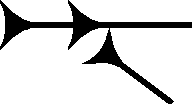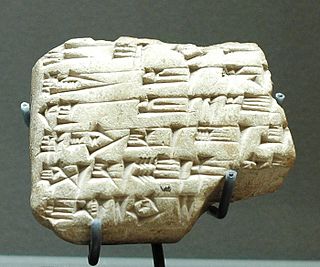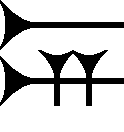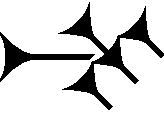
The cuneiform lu sign is a common, multi-use sign, a syllabic for lu, and an alphabetic sign used for l, or u; it has many other sub-uses, as seen in the Epic of Gilgamesh over hundreds of years, and the 1350 BC Amarna letters. Its other uses show other syllabic and alphabetic forms that it can be used for: other vowels, or consonants;. There are also four sumerogrammic sub-forms for "lu" in the Epic of Gilgamesh, LU, and UDU, and DAB and DIB; LU transposes to Akkadian language, "lullû", for English language, (primitive) man; DAB transposes to ṣabātu, English for to seize, capture.

The cuneiform ru sign is found in both the 14th century BC Amarna letters and the Epic of Gilgamesh. As ru it is used for syllabic ru, and alphabetic 'r', or 'u'. In the I-XII Tablets of the Epic of Gilgamesh, it has specific uses showing alternate renderings besides ru; as sign no. 068, ru, 250 times, šub, 6, šup, 3, and as Sumerogram ŠUB, 1 time. In the Amarna letters, the sign is mostly used for ru, r, and u in the spelling of various words. Notably, for "bird", Akkadian language "iṣṣūru", in Amarna letter EA 28,, titled "Messengers Detained and a Protest"; the messengers are referenced as "uncaged" birds, and "aren't they free to come and go as birds do?".

The cuneiform dan sign is a multi-use sign found in both the 14th century BC Amarna letters and the Epic of Gilgamesh. Besides dan,, the following are its uses :

The cuneiform qut sign, sign is found in both the 14th century BC Amarna letters and the Epic of Gilgamesh. It is a multi-use sign with 9 syllabic/alphabetic uses in the Epic of Gilgamesh; in the Amarna letters it is extremely common in the prostration formula, typical first paragraph of a letter, saying typically: "7 and 7 times,I bow down" ; a small group of Amarna letters are addressed to a different distinct personage in Egypt, under the Pharaoh.

The cuneiform Aš sign, is found in both the 14th century BC Amarna letters and the Epic of Gilgamesh. In the Epic, it has the following meanings, besides aš:

The cuneiform Ne sign, is found in both the 14th century BC Amarna letters and the Epic of Gilgamesh. In the Amarna letters, it is especially used in the opening, and introductory paragraph of the clay tablet letter, when addressing the Pharaoh (King), or when sent to another individual who is part of the Pharaoh's correspondence, for the alternate syllabic usage of "bil",. In the Amarna letters, it is used as Bil (cuneiform), for the spelling of speaks, or "says", in the opening statement; the Akkadian language word is "qabû", for to say, tell.

The cuneiform sign 𒀀 for a, and in the Epic of Gilgamesh the sumerogram A, Akkadian for mû, "water", which is used in the Gilgamesh flood myth, Chapter XI of the Epic, or other passages. The sign is also used extensively in the Amarna letters.

The cuneiform ia sign 𒅀, is a combined sign, containing i (cuneiform) ligatured with a (cuneiform); it has the common meaning in the suffix form -ia, for the meaning of "-mine". In the Amarna letters, the letters written to the Pharaoh of Egypt, the Pharaoh is often referenced as "Lord-mine", or especially: King-Lord-mine: "My King, My Lord". In Akkadian, the form is "Šarru-Bēlu-ia"-(King-Lord-mine), since the spelling in some Amarna letters is sometimes ŠÁR-RI for Šarru,.

The cuneiform DAGAL sign, which is a capital letter (majuscule) Sumerogram with the Akkadian language meaning of to be wide, or extensive; also "many", Akkadian "rapāšu", is a minor usage cuneiform sign used in the Amarna letters and the Epic of Gilgamesh. An equivalent usage sign for DAGAL is used in the Amarna letters, gáb, for Akkadian language "gabbu", and is found in such letters as EA 362, EA 367, and others. Gáb has other syllabic values, which are used for separate Akkadian word components.

Cuneiform sign nu is a common use syllabic, or alphabetic. It is restricted to "nu", but in the Epic of Gilgamesh, or elsewhere has a Sumerogram use NU, and probably mostly for a component in personal names (PN), god's names, or specialized names for specific items that use Sumerograms.

The cuneiform mi, sign is a distinctive sign in the wedge-stroke group, and is used as a syllabic for mi, me, and an alphabetic for m, i, or e; it is also a Sumerogram for MI, used for Akkadian language, "mūšu", night. MI, in the Epic of Gilgamesh, is used in (Chapters) Tablets I, II, III, and XII as either MI, or MI.MEŠ, a total of six times; other spellings of mūšu in other sections are alphabetic/syllabic, four times.

The cuneiform ŠEŠ sign, as a capital letter (majuscule), is a Sumerogram for Akkadian language ahu, for "brother". It is the cuneiform sign for ŠEŠ, as it can be used for a variety of lower case syllabic values, using š + vowel + š,. Sumerogram ŠEŠ has a high usage in the mid-14th century BC, ~1350-1330 BC Amarna letters from the brother kingdoms to the Pharaoh's Egypt. The brother kingdoms were Babylon, Alashiya, and Mittanni, where King Tushratta authored 13 El Amarna letters.

The cuneiform bi sign, also pí, and used for other syllabic forms, as well as a sumerogram, is a common use syllabic and alphabetic cuneiform sign used in both the mid-14th century BC Amarna letters and the Epic of Gilgamesh. In the Amarna letters, it is sometimes used for the spelling of the archers, 'pí-t(x)-t(x)', an often requested need from the Pharaoh in the vassal state sub-corpus of the letters.

The cuneiform na sign is a common, multi-use sign, a syllabic for na, and an alphabetic sign used for n, or a; it is common in both the Epic of Gilgamesh over hundreds of years, and the 1350 BC Amarna letters. In the Epic of Gilgamesh it also has sumerogramic usage for NA. An example usage for NA in the Epic is for the spelling of NA.GAD,, for Akkadian language "nāqidu", "herdsman". The usage for NA in herdsman is only for 3 spellings.

The cuneiform ha sign comes in two common varieties in the 1350 BC Amarna letters. It is also found in the large 12-chapter (Tablets I-XII) work of the Epic of Gilgamesh. Cuneiform ha is used as a syllabic for ha, and an alphabetic for h, or a; from the Epic of Gilgamesh it also has two sumerogramic uses (capital letter (majuscule)), for HA (Akkadian language zittu, for "share"), and KU6, for nūnu, "fish".

The cuneiform sign tu, and for TU-(the Sumerogram, capital letter, in the Hittite language and other cuneiform texts, is a common-use syllabic sign for tu, and also with a syllabic use for "t", or "u". It is not a multi-use sign, with other alphabetic sub-varieties.

The cuneiform sign ni is a common-use sign of the Amarna letters, the Epic of Gilgamesh, and other cuneiform texts. It has a secondary sub-use in the Amarna letters for addressing the Pharaoh, from the vassal states of Canaan. The address to the Pharaoh is often 'King-Lord-Mine': LUGAL, EN-ia which has many varieties of expression. "LUGAL" is Akkadian language for "Šarru", English "king", and EN in Akkadian is bēlu, for "Lord",. In some Amarna letters the sub-use of ni is lí, for spelling "bēlu", be-lí often .

The cuneiform sign mu, is a common-use sign of the Amarna letters, the Epic of Gilgamesh, and other cuneiform texts. It is also used as MU.

The cuneiform sign iš is a common use sign in the Amarna letters and the Epic of Gilgamesh. It is used syllabically for iš; also for mel, mil, and a Sumerogramic usage for IŠ. Alphabetically as "iš", its most common usage, it can be used for "i" or "š". In Akkadian, the four vowels a, e, i, o, are all interchangeable, and the three different "s", can also be interchanged: s, ṣ, š.

The cuneiform sign hal, is a common-use sign in the Epic of Gilgamesh, the Amarna letters, and other cuneiform texts, for example Hittite texts. Its common usage is syllabic for hal, but could also be use for alphabetic h or l, or the a, and for the other three vowels of e, i, or u.

















